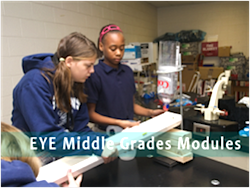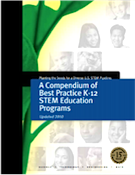Should All STEM Look Alike?
A MiddleWeb Blog
I was listening carefully – and to be honest, with a degree of wonder – as some recent workshop participants described their current STEM programs or STEM programs they’d like to initiate. So many unique “looks!” One thing became clear – each program had a unique twist – something that set it apart from the other programs and gave it identity.
• In one middle school the STEM program had students building and wiring robots, including robots that were controlled remotely by students and could navigate both steep hills and underwater.
• Another middle school uses STEM to prepare students to participate in high-level math and science programs in high school. They use STEM to help students learn these concepts by applying them to the real world.
• Still another middle school engages professionals in the fields of science, technology, engineering and math to serve as mentors and instructors as students tackle tough real-world challenges.

And then there’s the Air Force . . .
Probably the most “out of the box” and intriguing STEM program I’ve investigated recently is The Air Force Collaboratory. When this initiative first came across my virtual desk, I’ll admit to looking skeptically at the claim that it was a STEM program. Then I clicked on the link and got caught up in an absorbing search & rescue challenge that started with a gripping video scenario and engaged me in creative research.

These are just a few examples of the different approaches to STEM programs that successfully engage students in inquiry, logical reasoning and investigation. There are obviously different possibilities and designs for STEM programs.
As I reflected more deeply on all these examples, I wondered just how much variety can be present in programs that identify themselves as STEM. Are there components that must always be in place for something to earn the label “STEM”?
I think so. From my perspective as a STEM curriculum developer, I see several criteria that simply have to be present to make the leap from a less ambitious project-based learning activity to a genuine STEM initiative. I’ll mention just two that I think differentiate STEM from other PBL efforts.
What needs to be present in a STEM learning experience?
1. Science, Technology, Engineering, and Math must all be in the mix. In any STEM program, all four disciplines in the STEM acronym must be present in lessons and activities, and integrated (woven tightly together; interdependent) throughout the learning. Some activities may be more dependent on mathematics, while others may be more strongly connected to a science principle. While other disciplines may be brought in to enhance a STEM project, to identify a program or activity as STEM, each of the core STEM disciplines must also be present in a purposeful and significant way.
In STEM, technology falls into place as a vehicle that students use to solve their challenge, or it may be the outcome of their work. (Remember that anything made by humans to solve a human need or want is defined as “technology.” So student-designed devices are technologies.) Most importantly, the engineering component is the driver in all STEM programs. Engineering is the heart of the STEM process.

Let’s examine the EDP more closely. While there are different representations of this process, most of them contain the basic steps (or similar steps) shown here. As students work through a problem, they work through most of these steps – not necessarily in the order shown.
Note that not every lesson will contain all of these steps. For example one lesson may focus more on students developing multiple ideas to solve a problem, choosing one idea, and then creating a prototype. Other lessons may focus on testing and evaluating a prototype and then redesigning it, based on their findings. In the course of the year, all stages of the EDP should be embedded in the lessons and students should be familiar with using this process to solve problems.
How will you decide what your STEM program should look like?
STEM programs don’t necessarily look alike, but is one look “better” than the other? In my experience, the best STEM program is one that you can implement with the greatest chance of successful student STEM outcomes, and that depends on several different considerations.
► Consider the grade level. STEM needs to accomplish different things at different grade levels. If you work with elementary students, plan to give them introductory and foundational STEM activities. Guide students in inquiry-driven lessons focused on real world issues, and help them regard failure to solve a problem as a launching pad for more exploration. Spark their curiosity at every turn. Introduce a version of the EDP (a familiar elementary EDP is Ask, Imagine, Plan, Create, Improve). Be sure their science and math are intertwined and applied.

The high school STEM program needs to be a challenging and rigorous program of study. Students should understand and apply advanced science and math through hands-on engineering and technology projects. High schoolers need connections with the business leaders in your community to keep them grounded in the reality of what they are doing.
► Consider what purpose your STEM program is serving. Why and how did (or will) your STEM program come into being? The EYE initiative in Mobile, AL is a workforce and economic development STEM initiative. As new companies came into the city, the demand for a workforce literate in STEM subjects escalated. The EYE initiative began to inspire, prepare, and engage elementary and middle school students to take the coursework needed to support the growing demand for highly skilled and tech-savvy workers for the aerospace, shipbuilding, and other industries locating in the Mobile area. In some other school settings, the focus may be more generally on STEM-related careers.
► Consider your resources and current circumstances. You don’t always start where you want to end up. What can you successfully provide now, and what more detailed road map can you develop for where you want this STEM program to go? Decide what STEM lessons you can do with resources available. What workshops can teachers attend? Can you kick things off with a motivational speaker? What STEM challenges and tournaments might interest students and involve them in applying the math and science they are learning? Are after-school programs a possibility? Once you get things kicked off, a successful STEM effort will generally take on a life of its own. From there you can generate community support and energy to help build the program.
 A great launching pad
A great launching pad
The strongest STEM programs have sustained commitment and community support. Check out this compilation of K-12 STEM education programs for some ideas. And remember – remain faithful to the intent of STEM – keep the Science, Technology, Engineering, and Math in there – but have fun incorporating this specialized PBL into your curriculum. It’s a great launching pad for curiosity, investigation, critical thinking, teamwork, and problem-solving.




































Where does scientific inquiry fit into this????
Hi, Alan. The whole STEM process is an inquiry-based process. And STEM involves the application of scientific inquiry. Often, students do scientific investigations as the “research” component of the engineering design process. I didn’t mention inquiry as a STEM component above because I was identifying the things that differentiated STEM from other teaching approaches. Inquiry – and especially scientific inquiry – is a well-established approach that is used in a number of disciplines, so it doesn’t necessarily set STEM apart. It is, however, an integral part of STEM.
My son does not like his Engineering courses or Engineering teacher. He does not want to be an Engineer, but is interested in the STandM components. Should he continue with STEM? What are his alternatives?